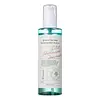What's inside
What's inside
 Key Ingredients
Key Ingredients

 Benefits
Benefits

 Concerns
Concerns

 Ingredients Side-by-side
Ingredients Side-by-side

Water
Skin ConditioningDecyl Glucoside
CleansingSodium Cocoyl Glutamate
CleansingChenopodium Quinoa Seed Extract
Skin ConditioningGlycerin
HumectantSodium Lauroyl Glutamate
Betaine
HumectantGlycine Soja Oil
EmollientMelaleuca Alternifolia Leaf Extract
PerfumingChlorphenesin
AntimicrobialHydroxyacetophenone
AntioxidantEthylhexylglycerin
Skin ConditioningCamellia Sinensis Leaf Extract
AntimicrobialHumulus Lupulus Extract
AntimicrobialOcimum Tenuiflorum Extract
Skin ConditioningCentella Asiatica Extract
CleansingCalendula Officinalis Flower Extract
MaskingPrunus Amygdalus Dulcis Fruit Extract
Skin ConditioningCitric Acid
BufferingGeranium Maculatum Oil
MaskingAllantoin
Skin ConditioningWater, Decyl Glucoside, Sodium Cocoyl Glutamate, Chenopodium Quinoa Seed Extract, Glycerin, Sodium Lauroyl Glutamate, Betaine, Glycine Soja Oil, Melaleuca Alternifolia Leaf Extract, Chlorphenesin, Hydroxyacetophenone, Ethylhexylglycerin, Camellia Sinensis Leaf Extract, Humulus Lupulus Extract, Ocimum Tenuiflorum Extract, Centella Asiatica Extract, Calendula Officinalis Flower Extract, Prunus Amygdalus Dulcis Fruit Extract, Citric Acid, Geranium Maculatum Oil, Allantoin
Water
Skin ConditioningGlycerin
HumectantDisodium Cocoamphodiacetate
CleansingCoco-Glucoside
CleansingLauryl Glucoside
CleansingSodium Chloride
MaskingSodium Cocoyl Apple Amino Acids
Skin ConditioningCeramide NP
Skin ConditioningSodium Hyaluronate
HumectantPanthenol
Skin ConditioningOenothera Biennis Oil
EmollientSimmondsia Chinensis Seed Oil
EmollientSclerocarya Birrea Seed Oil
HumectantLimnanthes Alba Seed Oil
Skin ConditioningHelianthus Annuus Seed Oil
EmollientCocos Nucifera Oil
MaskingHydroxypropyltrimonium Hyaluronate
Centella Asiatica Leaf Extract
Skin ConditioningOryza Sativa Bran Water
MaskingNelumbo Nucifera Flower Extract
Skin ConditioningSodium Acetylated Hyaluronate
HumectantHydrolyzed Hyaluronic Acid
HumectantChamomilla Recutita Flower Extract
MaskingHyaluronic Acid
HumectantSodium Hyaluronate Crosspolymer
HumectantHydrolyzed Sodium Hyaluronate
Skin ConditioningAcrylates/C10-30 Alkyl Acrylate Crosspolymer
Emulsion StabilisingHexylene Glycol
EmulsifyingCitric Acid
BufferingChlorphenesin
AntimicrobialEthylhexylglycerin
Skin ConditioningXanthan Gum
EmulsifyingTetrasodium Glutamate Diacetate
Butylene Glycol
Humectant1,2-Hexanediol
Skin ConditioningSaccharide Isomerate
HumectantCaprylic/Capric Triglyceride
MaskingHydrogenated Lecithin
EmulsifyingSodium Citrate
BufferingPotassium Hyaluronate
Skin ConditioningWater, Glycerin, Disodium Cocoamphodiacetate, Coco-Glucoside, Lauryl Glucoside, Sodium Chloride, Sodium Cocoyl Apple Amino Acids, Ceramide NP, Sodium Hyaluronate, Panthenol, Oenothera Biennis Oil, Simmondsia Chinensis Seed Oil, Sclerocarya Birrea Seed Oil, Limnanthes Alba Seed Oil, Helianthus Annuus Seed Oil, Cocos Nucifera Oil, Hydroxypropyltrimonium Hyaluronate, Centella Asiatica Leaf Extract, Oryza Sativa Bran Water, Nelumbo Nucifera Flower Extract, Sodium Acetylated Hyaluronate, Hydrolyzed Hyaluronic Acid, Chamomilla Recutita Flower Extract, Hyaluronic Acid, Sodium Hyaluronate Crosspolymer, Hydrolyzed Sodium Hyaluronate, Acrylates/C10-30 Alkyl Acrylate Crosspolymer, Hexylene Glycol, Citric Acid, Chlorphenesin, Ethylhexylglycerin, Xanthan Gum, Tetrasodium Glutamate Diacetate, Butylene Glycol, 1,2-Hexanediol, Saccharide Isomerate, Caprylic/Capric Triglyceride, Hydrogenated Lecithin, Sodium Citrate, Potassium Hyaluronate
 Reviews
Reviews

Ingredients Explained
These ingredients are found in both products.
Ingredients higher up in an ingredient list are typically present in a larger amount.
Chlorphenesin is a synthetic preservative. It helps protect a product against bacteria in order to extend shelf life. In most cases, Chlorphenesin is paired with other preservatives such as phenoxyethanol and caprylyl glycol.
Chlorphenesin is a biocide. This means it is able to help fight the microorganisms on our skin. It is also able to fight odor-releasing bacteria.
Chlorphenesin is soluble in both water and glycerin.
Studies show Chlorphenesin is easily absorbed by our skin. You should speak with a skincare professional if you have concerns about using Chlorphenesin.
Learn more about ChlorphenesinCitric Acid is an alpha hydroxy acid (AHA) naturally found in citrus fruits like oranges, lemons, and limes.
Like other AHAs, citric acid can exfoliate skin by breaking down the bonds that hold dead skin cells together. This helps reveal smoother and brighter skin underneath.
However, this exfoliating effect only happens at high concentrations (20%) which can be hard to find in cosmetic products.
Due to this, citric acid is usually included in small amounts as a pH adjuster. This helps keep products slightly more acidic and compatible with skin's natural pH.
In skincare formulas, citric acid can:
While it can provide some skin benefits, research shows lactic acid and glycolic acid are generally more effective and less irritating exfoliants.
Most citric acid used in skincare today is made by fermenting sugars (usually from molasses). This synthetic version is identical to the natural citrus form but easier to stabilize and use in formulations.
Read more about some other popular AHA's here:
Learn more about Citric AcidEthylhexylglycerin (we can't pronounce this either) is commonly used as a preservative and skin softener. It is derived from glyceryl.
You might see Ethylhexylglycerin often paired with other preservatives such as phenoxyethanol. Ethylhexylglycerin has been found to increase the effectiveness of these other preservatives.
Glycerin is already naturally found in your skin. It helps moisturize and protect your skin.
A study from 2016 found glycerin to be more effective as a humectant than AHAs and hyaluronic acid.
As a humectant, it helps the skin stay hydrated by pulling moisture to your skin. The low molecular weight of glycerin allows it to pull moisture into the deeper layers of your skin.
Hydrated skin improves your skin barrier; Your skin barrier helps protect against irritants and bacteria.
Glycerin has also been found to have antimicrobial and antiviral properties. Due to these properties, glycerin is often used in wound and burn treatments.
In cosmetics, glycerin is usually derived from plants such as soybean or palm. However, it can also be sourced from animals, such as tallow or animal fat.
This ingredient is organic, colorless, odorless, and non-toxic.
Glycerin is the name for this ingredient in American English. British English uses Glycerol/Glycerine.
Learn more about GlycerinWater. It's the most common cosmetic ingredient of all. You'll usually see it at the top of ingredient lists, meaning that it makes up the largest part of the product.
So why is it so popular? Water most often acts as a solvent - this means that it helps dissolve other ingredients into the formulation.
You'll also recognize water as that liquid we all need to stay alive. If you see this, drink a glass of water. Stay hydrated!
Learn more about Water